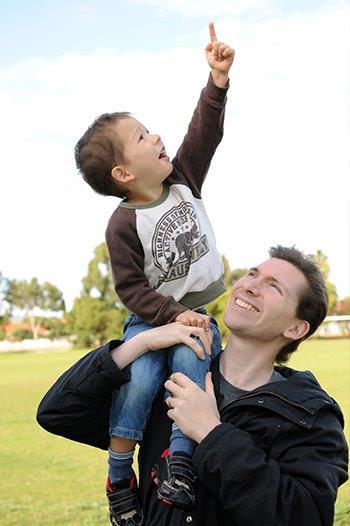Plane spotting
Duration/age

Is it a plane, is it a bird, is it Superman? No, it’s a jumbo jet bringing families home!
Often when you are outside or travelling around with your child they will notice a plane in the sky. When they do, talk to them about what they can see.
Can you see the plane flying in front of the cloud? Do you think it is a big plane or a small one?
That is a very big plane. How many engines can you see on it?
Talk with your child about the plane’s position in the sky and the direction it is travelling. Try and guess where you think it is going.
I think that plane is coming in to land at the airport. It is flying very low in the sky.
Materials you will need
- Your eyes and ears
- The sky
- Planes
Alternative tools
- The airport
Skills this activity improves
Why does this matter?
Children have a natural sense of wonder about the world around them. Talking about what they notice in the sky helps children to make sense of what they observe. It also helps them to organise the information into meaningful patterns.
Talking together about the planes you notice helps your child to ask questions. As they notice objects they can group them and compare the differences. As they talk about what they notice they are developing language to describe their thinking and observations.
When children begin to describe their thinking they have started to hypothesise. When they hypothesise they are beginning to connect what they see to past experiences and to use this information to make decisions, reflecting on why things have happened.
What does this lead to?
Some children are naturally curious and creative, taking risks in their learning. Children who are naturally curious and creative often notice and wonder about what they see around them. They will ask questions and create their own answers. These children have a natural disposition to be creative and curious.
Talking about and exploring the natural and everyday environment with your child will help them to develop the skills to notice, take risks and ask questions. Even if your child does not have a natural disposition to be creative and curious, by exploring and posing questions you are helping your child to experiment with different ways of thinking.
Language to use
- Plane, domestic, commercial, international, passenger, cargo, transport
- Size, small, large, jumbo
- Nose, tail, wings, engine, windows, door
- Direction, location, position, travelling, movement, distance
- North, south, east, west
- Pilot, passenger, airport
- Landing, take-off, taxiing, loading, descending
Questions to use
- Which direction is the plane travelling?
- Is it a big or a small plane?
- Where do you think the plane is going?
- How many people could fit inside the plane?
- How does the pilot know where to go?
- Are all planes the same size?
- Do all planes have the same number of engines?
- Why does a plane need wheels?
Useful tips
- When plane spotting remind your child not to look into the sun.
- Look for the plane schedule in the paper to find out when the international planes will arrive and depart.
- Remember to talk to your child in your home language.
More ideas
Take your child to the airport and watch the planes take-off and land.
Variation by age
Birth to two year olds
- Make a plane bingo card using the logos of the different airlines. Can you mark off all of the logos by the end of the week?
- Count how many planes you can see in an hour.
- Go plane spotting when the weather isn’t sunny. Can you still see the planes if it is cloudy?
Three to five year olds
- Make a plane bingo card using the logos of the different airlines. Can you mark off all of the logos by the end of the week?
- Use a compass to try and work out which direction the plane is travelling.
- Count how many planes you can see in an hour.
- Go plane spotting when the weather isn’t sunny. Can you still see the planes if it is cloudy?
Questions to ask
- Do planes still fly when it is raining?
- Do planes fly in front or behind the clouds?
- How do the planes see at night?
Questions to ask
- Do planes still fly when it is raining?
- Do planes fly in front or behind the clouds?
- How do the planes see at night?
Language to use
- Weather, rain, sun, clouds
- In front, behind, through, under, over
- Height, position
- Lights
Language to use
- Weather, rain, sun, clouds
- In front, behind, through, under, over
- Height, position
- Lights


